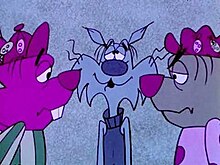
Sad Cat is an animated cartoon character created by director Ralph Bakshi at the Terrytoons studio in 1965. The character was the subject of 13 theatrical cartoons, which were syndicated to television in the early 1970s as part of The Astronut Show.[1] Eli Bauer and Al Kouzel wrote the cartoons.[2] Film critic and historian Leonard Maltin said that Sad Cat was "perhaps the dreariest character ever created at Terrytoons".[3]
Sad Cat was a put-upon feline, originally based on the Cinderella character. He lived in the city of Imagination with his two mean brothers, Latimore and Fenimore, and had a fairy godmouse named Gadmouse. In the first five cartoons directed by Bakshi, Gadmouse attempts to earn his wand and become a full-fledged good fairy by helping Sad Cat achieve his goals. Unfortunately, Gadmouse's schemes always go wrong, leaving Sad Cat still under his siblings' thumb.[1]
After Bakshi left the Terrytoons studio in 1967, Arthur Bartsch directed the eight further Sad Cat cartoons.[4] In these more upbeat cartoons, Gadmouse is replaced by Sad Cat's Super Ego, who transforms Sad Cat into a skilled competitor and helps him to triumph over his brothers in various contests, including a fishing competition, a golf tournament, and a judo match.[1]
Bob McFadden performed all of the voices for the cartoon, and was paid $150 for each cartoon. He explained, "They could play the cartoon for a thousand years and you would never get any more money, but you had to do all of the voices for the $150. That's why they wouldn't write women into the scripts because that would be two people they would have to pay."[5]